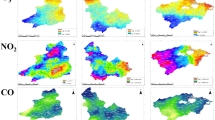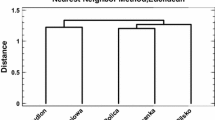Abstract
The present study was undertaken with the aim of using epiphytic lichens as sentinels for air pollution at two remote alpine sites (1,400 and 1,800 m above sea level (asl)) of NW Italy. The results indicated that the site at 1,800 m prompted for early warning indications of biological changes. Although levels of the many elements assayed in samples of the lichen Pseudevernia furfuracea (L.) Zopf, ranging from minor elements (e.g., Al) to ultra-trace (e.g., Pt), were at normal levels, indications of a slowly worsening environment were given by the lichen biodiversity and by damage to cell membranes. The analysis of Pb isotopic ratios suggested that the origin of Pb accumulated in lichens is not local, but linked to the long-range transport by air masses. It was concluded that the origin of pollutants is from air mass coming from the Po plain of Italy and from densely populated areas of Switzerland and France.

Similar content being viewed by others
References
Aboal JR, Fernandez JA, Boquete T, Carballeira A (2010) Is it possible to estimate atmospheric deposition of heavy metals by analysis of terrestrial mosses? Sci Total Environ 408:6291–6297
Alebic-Juretic A, Arko-Pijevac M (1989) Air pollution damage to cell membranes in lichens. Results of a simple biological test applied in Rijeka, Yugoslavia. Water Air Soil Pollut 47:25–33
Andersen A, Hovmand MF, Johnsen I (1978) Atmospheric heavy metal deposition in the Copenhagen area. Environ Pollut 17:133–151
Asta J, Erhardt W, Ferretti M, Fornasier F, Kirschbaum U, Nimis PL, Purvis W, Pirintsos SA, Scheidegger C, Van Haluwyn C, Wirth V (2002) Mapping lichen diversity as an indicator of environmental quality. In: Nimis PL, Scheidegger C, Wolseley PA (eds) Monitoring with lichens—monitoring lichens. Kluwer Academic, The Netherlands, pp 273–279
Bačkor M, Loppi S (2009) Interactions of lichens with heavy metals—a review. Biol Plant 53:214–222
Balaguer L, Manrique E, Ascaso C (1997) Predictability of the combined effects of sulphur dioxide and nitrate on the green-algal lichen Ramalina farinacea. Can J Bot 75:1836–1842
Bari A, Rosso A, Minciardi MR, Troiani F, Piervittori R (2001) Analysis of heavy metals in atmospheric particulates in relation to their bioaccumulation in explanted Pseudevernia furfuracea thalli. Environ Monit Assess 69:205–220
Beeby A (2001) What do sentinels stand for? Environ Pollut 112:285–298
Bergamaschi L, Rizzio E, Giavari G, Profumo A, Loppi S, Gallorini M (2004) Determination of baseline element composition of lichens using samples from high elevations. Chemosphere 55:933–939
Bettinelli M, Spezia S, Bizzarri G (1996) Trace element determination in lichens by ICP–MS. At Spectrosc 17:133–141
Bredemeier M (1988) Forest canopy transformation of atmospheric deposition. Water Air Soil Pollut 40:121–138
Brown DH, Avalos A, Miller JE, Bargagli R (1994) Interactions of lichens with their mineral environment. Cryptogam Bot 4:135–142
Buck GW, Brown DH (1979) The effect of desiccation on cation location in lichens. Ann Bot 44:265–277
Chiarenzelli J, Aspler L, Dunn C, Cousens B, Ozarko D, Powis K (2001) Multi-element and rare earth element composition of lichens, mosses, and vascular plants from the Central Barrenlands, Nunavut, Canada. Appl Geochem 16:245–270
Cislaghi C, Nimis PL (1997) Lichens, air pollution and lung cancer. Nature 387:463–464
Elkiey T, Ormrod DP (1979) Ozone and/or sulphur dioxide effects on tissue permeability of Petunia leaves. Atmos Environ 13:1165–1168
Ferry BW, Baddeley MS, Hawksworth DL (eds) (1973) Air pollution and lichens. Athlone Press, London
Fields RD, St. Clair LL (1984) A comparison of methods for evaluating SO2 impact on selected lichen species: Parmelia chlorochroa, Collema polycarpon and Lecanora muralis. Bryologist 87:297–301
Garty J, Karary Y, Harel J (1992) Effect of low pH, heavy metals and anions on chlorophyll degradation in the lichen Ramalina duriaei (De Not.) Bagl. Environ Exp Bot 32:229–241
Garty J, Karary Y, Harel J (1993) The impact of air pollution on the integrity of cell membranes and chlorophyll in the lichen Ramalina duriaei (De Not) Bagl. transplanted to industrial sites. Arch Environ Contam Toxicol 24:455–460
Gauslaa Y, Kopperud C, Solhaund KA (1996) Optimal quantum yield of photosystem II and chlorophyll degradation of Lobaria pulmonaria in relation to pH. Lichenologist 28:267–278
Hale ME (1983) The biology of lichens. Edward Arnold, London
Hawksworth DL, McManus PM (1989) Lichen recolonization in London under conditions of rapidly falling sulphur dioxide levels, and the concept of zone skipping. Bot J Linnaean Soc 100:99–109
Hissler C, Stille P, Krein A, Geagea ML, Perrone T, Probost JL, Hoffmann L (2008) Identifying the origins of local atmospheric deposition in the steel industry basin of Luxembourg using the chemical and isotopic composition of the lichen Xanthoria parietina. Sci Total Environ 405:338–344
Jaward FM, Di Guardo A, Nizzetto L, Cassani C, Raffaele F, Ferretti R, Jones KC (2005) PCBs and selected organochlorine compounds in Italian mountain air: the influence of altitude and forest ecosystem type. Environ Sci Technol 39:3455–3463
Kallenborn R (2006) Persistent organic pollutants (POPs) as environmental risk factors in remote high-altitude ecosystems. Ecotoxicol Environ Saf 63:108–112
Keddy PA (1991) Biological monitoring and ecological prediction: from nature reserve management to national state of the environment indicators. In: Goldsmith FB (ed) Monitoring for conservation and ecology. Chapman & Hall, London, pp 249–267
Kricke R, Loppi S (2002) Bioindication: The IAP approach. In: Nimis PL, Scheidegger C, Wolseley P (eds) Monitoring with lichens—monitoring lichens. Kluwer Academic, The Netherlands, pp 21–37
Loppi S, Corsini A (2003) Diversity of epiphytic lichens and metal contents of Parmelia caperata thalli as monitors of air pollution in the town of Pistoia (C Italy). Environ Monit Assess 86:289–301
Loppi S, Pirintsos SA (2003) Epiphytic lichens as sentinels for heavy metal pollution at forest ecosystems (central Italy). Environ Pollut 121:327–332
Loppi S, Cenni E, Bussotti F, Ferretti M (1997a) Epiphytic lichens and tree leaves as biomonitors of trace elements released by geothermal power plants. Chem Ecol 14:31–38
Loppi S, Nelli L, Ancora S, Bargagli R (1997b) Passive monitoring of trace elements by means of tree leaves, epiphytic lichens and bark substrate. Environ Monit Assess 45:81–88
Loppi S, Pirintsos SA, De Dominicis V (1999) Soil contribution to the elemental composition of epiphytic lichens (Tuscany, central Italy). Environ Monit Assess 58:121–131
Loppi S, Giordani P, Brunialti G, Isocrono D, Piervittori R (2002) A new scale for the interpretation of lichen biodiversity values in the Tyrrhenian side of Italy. Bibl Lichenologica 82:237–243
Loppi S, Frati L, Paoli L, Bigagli V, Rossetti C, Bruscoli C, Corsini A (2004) Biodiversity of epiphytic lichens and heavy metal contents of Flavoparmelia caperata thalli as indicators of temporal variations of air pollution in the town of Montecatini Terme (central Italy). Sci Total Environ 326:113–122
Mahaney WC, Wilson E, Boyer MG, Hancock RGV (1995) Marginal bleaching of thalli of Rhizocarpon as evidence for acid rain in the Norra storfjället, Sweden. Environ Pollut 97:71–75
Manning WJ, Feder WA (1980) Biomonitoring air pollutants with plants. Kluwer, The Netherlands
Marques AP, Freitas MC, Wolterbeek HT, Steinebach OM, Verburg T, De Goeij JJ (2005) Cell-membrane damage and element leaching in transplanted Parmelia sulcata lichen related to ambient SO2, temperature, and precipitation. Environ Sci Technol 39:2624–2630
Munzi S, Pisani T, Loppi S (2009) The integrity of lichen cell membrane as a suitable parameter for monitoring biological effects of acute nitrogen pollution. Ecotoxicol Environ Saf 72:2009–2012
Nascimbene J, Isocrono D, Marini L, Caniglia G, Piervittori R (2006) Epiphytic lichen vegetation on Larix in the Italian Alps. Plant Biosyst 140:132–137
Nash TH, Gries C (2002) Lichens as bioindicators of sulfur dioxide. Symbiosis 33:1–21
Nimis PL, Martellos S (2008) ITALIC - The Information System on Italian Lichens. Version 4.0. University of Trieste, Department of Biology, IN4.0/1 (http://dbiodbs.univ.trieste.it/)
Nizzetto L, Cassani C, Di Guardo A (2006) Deposition of PCBs in mountains: the forest filter effect of different forest ecosystem types. Ecotoxicol Environ Saf 63:75–83
Paoli L, Loppi S (2008) A biological method to monitor early effects of the air pollution caused by the industrial exploitation of geothermal energy. Environ Pollut 155:383–388
Paoli L, Pisani T, Guttova A, Sardella G, Loppi S (2011) Physiological and chemical response of lichens transplanted in and around an industrial area of south Italy: relationship with the lichen diversity. Ecotoxicol Environ Saf 74:650–657
Pirintsos SA, Loppi S (2008) Biomonitoring atmospheric pollution: the challenge of times in environmental policy on air quality. Environ Pollut 151:269–271
Puckett KJ, Nieboer E, Flora W, Richardson DHS (1973) Sulphur dioxide: its effect on photosynthetic 14C fixation and suggested mechanisms of phytoxicity. New Phytol 72:141–154
Puckett KJ, Tomassini FD, Nieboer E, Richardson DHS (1977) Potassium efflux by lichen thalli following exposure to aqueous sulphur dioxide. New Phytol 79:135–145
Purvis OW, Seaward MRD, Loppi S (2007) Lichens in a changing pollution environment: an introduction. Environ Pollut 146:291–292
Rinne RJK, Barclay-Estrup P (1980) Heavy metals in a feather moss, Pleurozium schreberi, and in soils in NW Ontario, Canada. Oikos 34:59–67
Silberstein L, Siegel BZ, Siegel SM, Mukhtar A, Galun M (1996) Comparative studies on Xanthoria parietina, a pollution-resistant lichen, and Ramalina duriei, a sensitive species. I. Effects of air pollution on physiological processes. Lichenologist 28:355–365
Simonetti A, Gariépy C, Carignan J (2003) Tracing sources of atmospheric pollution in Western Canada using the Pb isotopic composition and heavy metal abundances of epiphytic lichens. Atmos Environ 37:2853–2865
Sloof JE (1995) Lichens as quantitative biomonitors for atmospheric trace-element deposition using transplant. Atmos Environ 29:11–20
Spiro B, Weiss DJ, Purwis OW, Mikhailova I, Williamson BJ, Coles BJ, Udacvhin V (2004) Lead isotopes in lichen transplants around a Cu smelter in Russia dewtermined by MC-ICP_MS reveal transient records of multiple sources. Environ Sci Technol 38:6522–6528
Stroppiana D, Boschetti M, Brivio PA, Nizzetto L, Di Guardo A (2012) Forest leaf area index in an Alpine valley from medium resolution satellite imagery and in situ data. J Appl Remote Sens 6:1–16
Tarhanen S, Holopainen T, Oksanen J (1997) Ultrastructural changes and electrolyte leakage from ozone fumigated epiphytic lichens. Ann Bot 80:611–621
Tomassini FD, Lavoie P, Puckett KJ, Nieboer E, Richardson DHS (1977) The effect of time exposure to sulphur dioxide on potassium loss from and photosynthesis in the lichen, Cladina rangiferina (L.) Harm. New Phytol 79:147–155
Van Dobben HF, Ter Braak JF (1998) Effects of atmospheric NH3 on epiphytic lichens in The Netherlands: the pitfalls of biological monitoring. Atmos Environ 32:551–557
Van Dobben HF, Ter Braak JF (1999) Ranking of epiphytic lichen sensitivity to air pollution using survey data: a comparison of indicator scales. Lichenologist 31:27–39
Zakshek EM, Puckett KJ, Percy KE (1986) Lichen sulphur and lead levels in relation to deposition patterns in eastern Canada. Water Air Soil Pollut 30:161–169
Zechmeister HG, Hagendorfer H, Hohenwallner D, Hanus-Illnar A, Riss A (2006) Analyses of platinum group elements in mosses as indicators of road traffic emissions in Austria. Atmos Environ 40:7720–7732
Acknowledgments
This paper is dedicated to the memory of the late Prof. Carlo Gaggi, eminent ecotoxicologist and above all a dear friend. Thanks are due to Dr. L. Frati, Dr. S. Santoni, Dr. V. Nicolardi, and Prof. G. Protano for sharing field and lab work.
Author information
Authors and Affiliations
Corresponding author
Additional information
Responsible editor: Elena Maestri
Rights and permissions
About this article
Cite this article
Loppi, S. Lichens as sentinels for air pollution at remote alpine areas (Italy). Environ Sci Pollut Res 21, 2563–2571 (2014). https://doi.org/10.1007/s11356-013-2181-0
Received:
Accepted:
Published:
Issue Date:
DOI: https://doi.org/10.1007/s11356-013-2181-0




